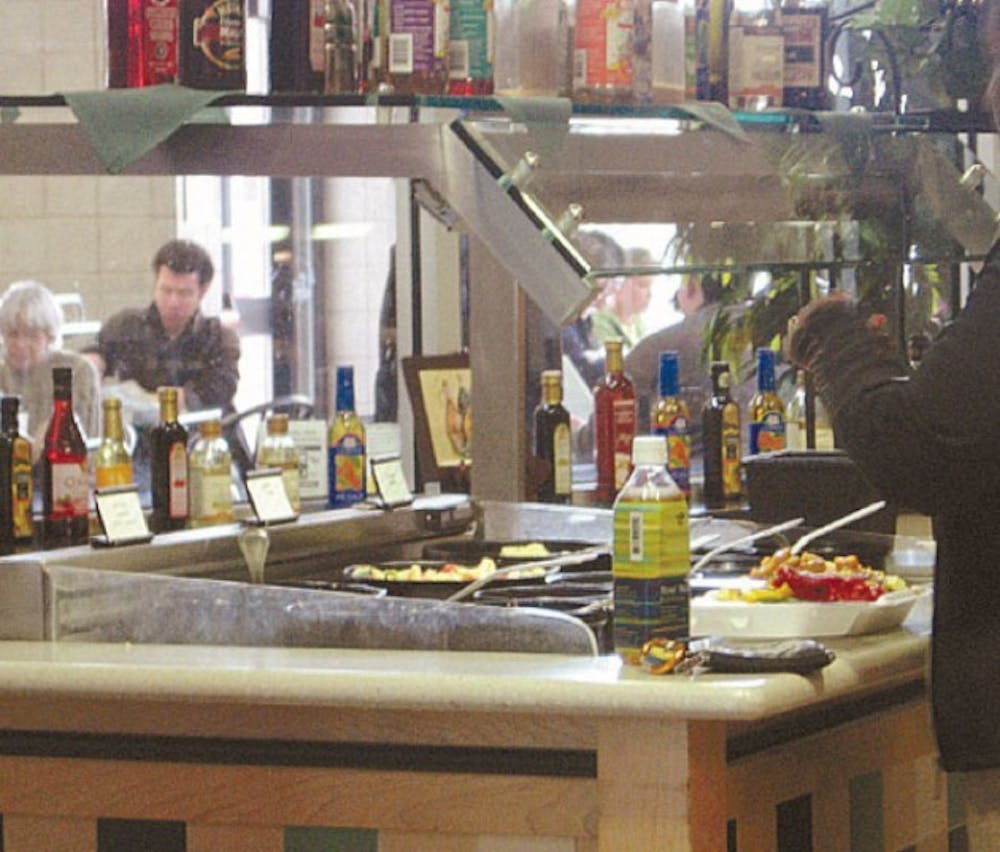Between adjusting to a cram-packed academic schedule, living away from home for the first time and the constant lure of fried food on campus, developing healthy eating habits often comes as a challenge for college students.
While some students pack on the calories with daily doses of burgers and fries, others completely avoid the temptation. At first glance, UB's dining options seem to favor heavy eaters, but Campus Dining and Shops is working to satisfy the health-conscious as well.
Alex Shen, a senior pharmacy major, looks back on his freshman year as a time of overeating and taking advantage of his abundant meal plan.
"I had my freshman 20," Shen said. "I ate a lot because I had a gold meal plan. So I ate all I wanted and beyond. Plus, I tended to snack a lot because of the excessive dining dollars."
Maggie Moore, a senior exercise science major, had a completely different experience. Not only did Moore maintain a healthy weight in college, but she also found that the dorm lifestyle enabled her to more easily control what she ate.
"I eat healthier because I control what I keep in my room," Moore said. "For example, at home my mom always had cookies and other baked goods around which I ate all the time. At school, I don't keep bad food in my room."
Janice Cochran, a dietitian with Wellness Education Services, says that it's normal for college students to have such varied dietary experiences, and debunks the notion of the infamous "freshman 15."
"The ‘freshman 15' is not a proven term," Cochran said. "Many college freshmen gain four to nine pounds, some gain more, a few are still growing, and some lose weight. Rather than diet at the first sign of weight gain, instead observe how your habits have changed and figure out how you can bring those healthier eating and moving habits back into your life, given your new environment and schedule."
Despite these differences, Cochran believes that many college students make the same mistake when it comes to eating – failing to factor meal times into their busy routines.
"Many students don't plan ahead and many miss meals," Cochran said. "This encourages haphazard, unbalanced eating [and] grabbing whatever's available. Missing meals, typically breakfast, is a common reason why students may eat more at night, when they're tired or the choices available to them are often more calorie-dense."
Jeff Brady, the executive director of Campus Dining and Shops, says CDS is working to accommodate students who don't have time to eat until the evening. This academic year, two meal swipes will be allowed per meal period, and a late night meal exchange will be added.
Cochran doesn't advocate one particular eating routine, but she encourages students to find the one that works for them – at the same time ensuring that they consume adequate nutrients.
"One person may have two meals per day and two or three snacks," Cochran said. "Another person will have three meals per day. Someone else may have six small meals. All can work. However, dropping to two meals per day or less will be detrimental to energy and metabolism, so three meals would be a minimum, or two meals and two snacks, for example."
Brady believes that the recently initiated Take a Fresh Look program proves useful to students with vastly different nutritional needs.
"In the residential dining centers, you will find near almost all menu items a Cuisine Card that offers useful information that can help in making decisions to support dietary goals and allergy alert information," Brady said. "Use the Cuisine Cards to plan meals and budget fat, cholesterol, and sodium intake."
For many underclassmen, the majority of their meals come from the buffet-style dining halls. While some students enjoy residential dining options, others wish they offered more variety and nutritional value.
"Freshman year I had a meal plan," said Kelley Dunnigan, a senior pharmacy major. "The food selection gets boring after a while and most things are fried."
Brady believes healthy choices are available at all campus dining locations, but names a few specific low-calorie eateries.
"One of the best locations for healthy choices is Pistachio's," Brady said. "The Bread Box Deli offers many different choices for sandwiches including whole grain breads and plenty of fresh vegetables."
During the early summer, Pistachio's dining room was completely remodeled, creating a restaurant look with new lighting, carpeting, café tables, stand up bars and background music.
He added that Putnam's in the Student Union will be opening a brand new fresh salad concept called Edgie Veggie in the fall, offering romaine, spring mix and locally grown salads with toppings ranging from fresh avocado to locally grown asparagus.
Brittany Chilson, a senior exercise science major, thinks students have to go a bit out of their way to eat healthily, but is glad that CDS is beginning to advertise these choices more.
"You have to dig to eat well, which is why I can understand why so many people don't because it is so much easier not to care," Chilson said. "I know they are making more of an attempt to show their healthy options, so that is nice."
Amelia Vangellow, a sophomore undecided major, acknowledges that eating well at UB requires some self-control.
"There definitely were healthy options, but having unhealthy options right next to those sometimes made it hard to eat healthy," Vangellow said. "I guess you just have to have willpower."
Questions? Comments? Have a better idea?
E-mail: features@ubspectrum.com





